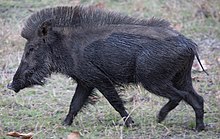Indian boar
| Indian boar | |
|---|---|

| |
| Indian boar, Bandhavgarh National Park, India | |
| Scientific classification | |
| Domain: | Eukaryota |
| Kingdom: | Animalia |
| Phylum: | Chordata |
| Class: | Mammalia |
| Order: | Artiodactyla |
| Family: | Suidae |
| Genus: | Sus |
| Species: | |
| Subspecies: | S. s. cristatus
|
| Trinomial name | |
| Sus scrofa cristatus Wagner, 1839
| |
| Synonyms[1] | |
|
Species synonymy
| |
The Indian boar (Sus scrofa cristatus), also known as the Moupin pig,[2] is a subspecies of wild boar native to India, Nepal, Myanmar, western Thailand, Bangladesh and Sri Lanka.
The Indian boar differs from the Central European Boar by its large mane which runs in a crest along its back from its head to lower body, larger, more sharply featured and straighter skull, its smaller, sharper ears and overall lighter build.[3] It is taller and more sparsely haired than the European form, though its back bristles are much more developed.[2] The tail is also more tufted, and the cheeks hairier.[4] Adults measure from 83.8 to 91.4 cm (33 to 36 in) in shoulder height (with one specimen in West Bengal having reached 38 inches) and five feet in body length. Weight ranges from 90.7 to 136.1 kg (200 to 300 lb).[2]
The animal has interacted with humans in the Indian Subcontinent since the Upper Paleolithic, with the oldest depiction being a cave painting in Bhimbetaka rock shelters,[5] and it occasionally appears in Hindu mythology. A story present in the Brahmanas says that Indra killing a evil boar, who has stolen the treasure of the asuras, then giving its carcass to Vishnu, who offers it as a sacrifice to the gods and goddesses and they eat it. In a story in Charaka Samhita, a boar named Ermusha is a avatara of Brahma and he raises the earth and sky from the primeval waters of the universe during creation and creates the universe. In the Ramayana, Mahabharata and the Puranas, another boar, Varaha is an avatar of Vishnu that kills Hiranyaksha and saves Bhumi.[6]
See also
References
- ^ Wozencraft, W. C. (2005). "Order Carnivora". In Wilson, D. E.; Reeder, D. M. (eds.). Mammal Species of the World: A Taxonomic and Geographic Reference (3rd ed.). Johns Hopkins University Press. pp. 532–628. ISBN 978-0-8018-8221-0. OCLC 62265494.
- ^ a b c Lydekker, R. (1900), The great and small game of India, Burma, & Tibet, London : R. Ward, pp. 258-266
- ^ Sterndale, R. A. (1884), Natural history of the Mammalia of India and Ceylon, Calcutta : Thacker, Spink, pp. 415-420
- ^ Jerdon, T. C. (1874), The mammals of India; a natural history of all the animals known to inhabit continental India, London, J. Wheldon, pp. 241-244
- ^ Mayer, John J., "Wild Pig Attacks on Humans" (2013). Wildlife Damage Management Conferences – Proceedings. Paper 151. http://digitalcommons.unl.edu/icwdm_wdmconfproc/151
- ^ Macdonell, A. A. (1898), Vedic Mythology, Motilal Banarsidass Publ., p. 41
External links
 Media related to Sus scrofa cristatus at Wikimedia Commons
Media related to Sus scrofa cristatus at Wikimedia Commons
